
Both men and women are prone to varicose veins, but the weaker sex often suffers from the consequences of this disease. Most often there are associations with the mention of varicose veins with swelling of the veins in the legs below the knee, but there is such a thing as varicose veins of the pelvis in women. This is a fairly common disease in which all women of childbearing age are at risk of contraction.
The most common pelvic varicose veins appear in women who do heavy physical work or during pregnancy. This is due to the increased stress on the female body, which causes increased venous pressure, which leads to varicose veins in the hip.
Sudden pain in the lower abdomen is the first symptom of varicose veins in the pelvis.
Varicose veins of the internal organs are particularly dangerous for pregnant women and one of the main reasons for prescribing a caesarean section. Doctors explain this by saying that natural birth can cause bleeding and the lives of both mother and child are at risk. The incidence of this disease during pregnancy is due to the fact that the enlarged uterus is compressed and adversely affects normal blood circulation. Elevated hormone levels also contribute to the appearance of varicose veins in the pelvis.
Due to changes in hormone levels in mature women, the disease can develop during puberty. The situation is complicated by the fact that it is quite difficult to detect varicose veins of the pelvic veins, since the disease that appeared during this period of life rarely progresses with obvious symptoms. An indirect reason for visiting a specialist can be an increased discharge from the organs of the female reproductive system.
Very often women develop varicose veins of the pelvis while sitting down in the office. This is caused by the loss of the plasticity of the vein walls due to a person's poor mobility. Men are also prone to this disease, but much less often than women.
The most obvious symptom of pelvic varicose veins can lead to more frequent pain in the lower abdomen, especially when standing with the body upright. Often times, pain can be caused by sexual intercourse or other heavy loads on the body. From the small pelvis, varicose veins can also spread to the perineum and buttock region.
Experts attribute complex diseases to internal varicose veins of the small pelvis. This is due to the difficulty in diagnosing it, since there are not so many symptoms of the onset of the disease and they are not clearly manifested. The timeliness of the detection of varicose veins gives hope for a full recovery. There is also a high likelihood of misdiagnosis early in the development of the disease.
The main causes of the disease
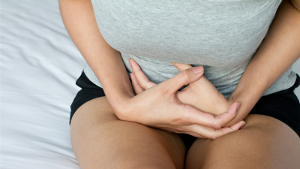
Bad heredity can be the problem.
Connective tissue dysplasia is considered a harbinger of its pathology, which causes varicose veins of the pelvic vessels. Often times these problems are caused by poor inheritance, but people whose lives are linked to the following factors can also have varicose veins:
- Office work or other sedentary work;
- Heavy physical activity if the body is not prepared for it in advance;
- Irregular sexual activity;
- High estrogen hormone;
- Gynecological diseases in women, frequent inflammation;
- tumors near internal organs.
The studies carried out prove the connection between the use of contraceptives and other hormonal drugs with the occurrence of varicose veins in the pelvis.
The detection of this disease in pregnant women requires special attention. Unfortunately, up to 30% of all cases in women are observed during this time. Doctors tend to believe that pregnancy can stimulate the appearance of connective tissue dysplasia in a woman's body, which leads to varicose veins.
Varicose veins of the pelvis in women occur due to an increase in the number of female hormones in the body, their effect has a similar effect on the body when using contraceptives. This is made worse by the fact that during the development of the fetus, pressure is put on the internal veins of the pelvis, which leads to increased compression. Additional pathways for blood outflow are created that are no longer needed after birth, and a recovery procedure is required to get rid of them.
In the maternity hospital for those who register, there is a risk group that includes women with a predisposition to inflammation of the reproductive organs. Pregnant women with high levels of estrogen also need special attention.
Disease symptoms

The main symptoms of varicose veins in the pelvic organs are frequent pain in the lower abdomen and copious discharge of mucus from the genitals. However, these signs may also be due to other reasons why it is so difficult to diagnose such pelvic varicose veins at an early stage.
Indirect signs include the detection of swollen veins in the buttocks and perineum. In some patients, lower abdominal pain increases during the first few days of the menstrual cycle.
The main symptoms that indicate varicose veins in the pelvis in women include:
- Pain before menstruation worse than usual;
- menstrual disorders;
- Enhancement of sensitive sensations in the perineal area;
- pain radiating from the lower abdomen to the lower back;
- Increased vaginal sensitivity;
- Frequent urination;
- Severity of the lumbar spine when standing or sitting for long periods of time.
Depending on the stage of development of the pelvic varicose veins and the individual characteristics of each woman, several symptoms can be observed simultaneously or individually. In any case, you should visit the gynecologist's office if any of the listed signs are detected.
Diagnostic methods
There are several methods of detecting and diagnosing varicose veins of the pelvic organs, but Doppler ultrasound is considered the most important. In this procedure, using ultrasound waves, it is possible to identify the contours of the veins and project them onto the screen of the device or take a photo. The picture allows you to see all the places of deformation of the veins, the flow of which is reduced.
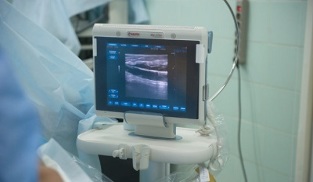
For a clearer picture, doctors use venography in diagnostics. The uterine veins are filled with a substance that creates a contrast during fluoroscopy.
Difficulties in diagnosis, as well as mild symptoms, are the lack of a specific localization site, varicose veins of the pelvis.
When diagnosed by a doctor, varicose veins can be mistaken for a common inflammatory process. The likelihood of such an error is particularly high in the early stages.
Important!If the gynecologist has diagnosed inflammation and prescribed therapy, but it does not help manage the symptoms, it must be understood that such an effect is not normal and a second visit to the doctor is imperative.
With a lot of confidence you can make a correct diagnosis using the following methods:
- Doppler ultrasound;
- Phlebography - fairly accurately diagnoses varicose veins of the pelvis;
- Ultrasound of the venous system - a vaginal examination or transabdominal scanning is used in different situations;
- Laparoscopy - thanks to this method, you can also identify varicose veins in the ovaries.
- Selective Ovarian Ecography - This diagnostic method is most likely to detect varicose veins in the pelvis. For this purpose, contrast agent is injected into the veins of the thighs and the subclavian.
If the diagnosis does not provide accurate results, the patient can be sent for an additional examination. A blood test is mandatory.
Classification of the degree of disease
Depending on the stage and severity of the iliac varicose veins, it can be divided into three categories. An important parameter in this regard is also the location of the venous dilation.
- varicose veins in the small pelvis in the first stage inflate the veins due to the appearance of a small number of deformed areas up to 5 mm;
- In the second stage, the veins are 6-10 mm in diameter, and loose ectasia of the plexus occurs in the ovary.
- The last degree is the most dangerous, the patient's venous swelling exceeds a volume of 10 mm. The third degree of damage is characterized by parametric localization of the main type.
After successful diagnosis and determination of the stage of the disease, appropriate treatment of the varicose veins is prescribed.
Conservative treatment methods
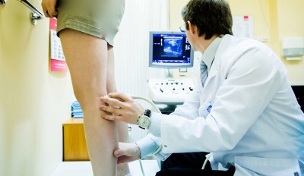
It is best to contact the appropriate specialists after an accurate diagnosis has been made. Diseases associated with varicose veins are treated by a phlebologist. You may not be able to get a referral until the diagnosis has been made by a gynecologist and the dilation of the pelvic veins in men has been confirmed by a urologist.
The main tasks that the doctor set on the way to the patient's recovery are:
- Restoring damaged vein walls and returning to their usual tone;
- Prevents the formation of subsequent blood stagnation in the veins of the small pelvis;
- Improvement of the condition of the venous tissue.
To solve the set tasks, a complex therapy is used, which includes a special diet, rehabilitation exercises, drugs for the treatment of varicose veins and the use of specially shaped underwear.
Therapeutic treatment phase
The main goal of therapy for small varicose veins in the pelvis is to restore blood flow and normalize the tone of elastic tissues. The stages of eliminating unpleasant symptoms of the disease and increasing blood flow to the veins are no less important.
Preparations for varicose veins should only be prescribed by a phlebologist. There are two groups of drugs that are prescribed for this disease. The first (venotamic medicine) - improves the tone of the venous tissue, and the second (angiagregants) - prevents the formation of new blood clots.
If the varicose veins of the small pelvis worsen, taking medication in courses is an important part of therapy. The main role in treatment is played by venotonic drugs that improve vascular tone. To prevent the disease from recurring, these drugs are prescribed for prophylaxis.
Preparations for the treatment of varicose veins of the pelvis can only be prescribed by a doctor, self-medication is unacceptable!

In general, preparations for varicose veins contribute to:
at- Stop the backflow of blood.
- normalization of venous tone;
- Helps with blood supply to the tissue;
- Reduction of discomfort due to symptoms of illness.
It should be noted that the use of medication must be combined with special exercises and a prescribed diet.
Traditional medicine
For the treatment of varicose veins of the small pelvis, they often resort to folk methods, the main remedies of which include herbal infusions, which restore the normal tone of the veins. The most popular decoctions are horse chestnut, chaga and dandelion roots.
Hirudotherapy has proven itself in humans: leeches should be used in the area of the sacrum and coccyx.
Important to know!It is impossible to let the uncovered varicose veins float in the small pelvis or to trust only the means of traditional medicine. This rather dangerous disease should be treated comprehensively, with the mandatory use of drugs, and the use of infusions and decoctions can only be an additional remedy.
Preventive gymnastics
There are several physical training techniques that can be used to restore tissue tone.
- Raising and lowering the toes, the exercise is performed standing, the number of repetitions is at least 30, the toes and heels are parallel;
- The same thing is enough if you just spread your socks apart and straighten your heels 30 times.
- Repeat the toe lift, spreading your heels as much as possible and bringing your toes together.
- Pelvic varicose veins can be treated with breathing exercises to slow this down by imagining how all of the abdominal muscles are affected.
- In the prone position, lift your pelvis, support it with your hands and make a "bicycle" movement. If you find this exercise difficult, you can replace it with a "birch" or alternate it.
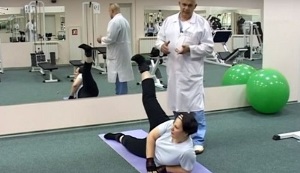
Physiotherapy works well when the veins of the small pelvis are dilated. Plus, it's convenient to do it anywhere. The main requirement for success is the regularity of performing special exercises. In no case should you overexert yourself during the class.
It is also important to lead a healthy lifestyle if you have been diagnosed with venous dilatation. During physical work, you should take regular breaks. If this involves staying in a static position for a long time, then you should regularly take breaks, warm up, and walk.
A good solution would be to use a contrast shower. Varicose veins cause uncomfortable sensations in the perineal area, so it is not unnecessary to direct the water jet on this particular area.
Proper nutrition
It is important to develop a diet so that there are no problems with stool, especially constipation. With them, venous expansion can be aggravated by an increase in internal pressure during bowel movements. It is also better to exclude foods that are too spicy and fatty, as these will affect the formation of blood clots.
The nutritional correction for varicose veins in the pelvis implies the exclusion of foods with a high content of saturated fatty acids and alcoholic beverages. When it comes to diet, foods rich in fiber (vegetables and fruits, cereals) and healthy fats (vegetable oils) should be preferred.
Having learned from the doctor how to treat varicose veins of the pelvis and the restrictions on the use of food, it is worth taking care of the general condition of the body. Therefore, it is better to give up bad habits (smoking and alcohol) during rehabilitation.
Possible complications
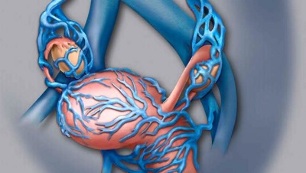
Varicose veins of the pelvic organs can cause serious complications for the female body, especially in the later stages of the disease. Sometimes the inflammation spreads to neighboring organs, bleeding in the uterus looks more terrifying.
For better protection, understand the danger of pelvic varicose veins. Frequent bleeding in the uterus can contribute to the formation of thrombosis and develop into an extensive inflammatory process.
Forecast
Pelvic varicose veins in women can contribute to the development of serious complications, but most often appear in later stages due to the delayed detection of the disease. Therefore, you should pay attention to pain with pelvic varicose veins, as these are the most obvious symptom and signal the need to see a doctor.

























